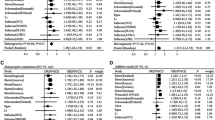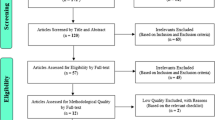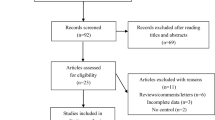Abstract
Previous studies have shown the association of the Cyclin D1 (CCND1) G870A polymorphism with glioma risk, but the findings are inconsistent and inconclusive. To shed some light on the findings across individual studies and acquire a quantitative assessment of this association, we conducted a meta-analysis of all published case–control studies thus far. Four independent studies with a total of 690 cases and 1,014 controls were identified after a systematic search of the PubMed, Embase, Web of Science, and Wanfang databases. The strength of the association between the CCND1 G870A polymorphism and glioma risk was estimated by the pooled odds ratios (ORs) with 95 % confidence intervals (95 %CIs). Subgroup analysis by ethnicity was also performed. Overall, a statistically significant association was found between the CCND1 G870A polymorphism and glioma risk in three genetic models (ORA vs. G = 1.178, 95 %CI 1.025–1.354, P OR = 0.021; ORAA vs. GG = 1.328, 95 %CI 1.007–1.750, P OR = 0.045; ORAA + AG vs. GG = 1.253, 95 %CI 1.006–1.516, P OR = 0.044). In subgroup analysis, the pooled ORs suggested that the CCND1 G870A polymorphism was associated with an increased risk of glioma in Caucasians under the heterozygote and dominant genetic models (ORAG vs. GG = 1.329, 95 %CI 1.001–1.766, P OR = 0.049; ORAA + AG vs. GG = 1.332, 95 %CI 1.019–1.740, P OR = 0.036). The meta-analysis suggests that the CCND1 G870A polymorphism is a risk factor for the development of glioma.



Similar content being viewed by others
References
Jemal A, Siegel R, Ward E, Hao Y, Xu J, Thun MJ. Cancer statistics, 2009. CA Cancer J Clin. 2009;59(4):225–49.
Jemal A, Bray F, Center MM, Ferlay J, Ward E, Forman D. Global cancer statistics. CA Cancer J Clin. 2011;61(2):69–90.
Chen P, Wiencke J, Aldape K, Kesler-Diaz A, Miike R, Kelsey K, et al. Association of an ERCC1 polymorphism with adult-onset glioma. Cancer Epidemiol Biomark Prev. 2000;9(8):843–7.
Wrensch M, Minn Y, Chew T, Bondy M, Berger MS. Epidemiology of primary brain tumors: current concepts and review of the literature. Neuro Oncol. 2002;4(4):278–99.
Bedewy AM, Mostafa MH, Saad AA, El-Maghraby SM, Bedewy MM, Hilal AM, et al. Association of cyclin D1 A870G polymorphism with two malignancies: acute lymphoblastic leukemia and breast cancer. J BUON. 2013;18(1):227–38.
Cakina S, Gulyasar T, Ozen A, Sipahi T, Kocak Z, Sener S. Relationship between cyclin D1 (A870G) gene polymorphism and lung cancer. Indian J Biochem Biophys. 2013;50(3):233–6.
Li J, Luo F, Zhang H, Li L, Xu Y. The CCND1G870A polymorphism and susceptibility to bladder cancer. Tumour Biol. 2014;35(1):171–7.
Sameer AS, Parray FQ, Dar MA, Nissar S, Banday MZ, Rasool S, et al. Cyclin D1 G870A polymorphism and risk of colorectal cancer: a case control study. Mol Med Rep. 2013;7(3):811–5.
Zeybek U, Yaylim I, Ozkan NE, Korkmaz G, Turan S, Kafadar D, et al. Cyclin D1 gene G870A variants and primary brain tumors. APJCP. 2013;14(7):4101–6.
Knudsen KE, Diehl JA, Haiman CA, Knudsen ES. Cyclin D1: polymorphism, aberrant splicing and cancer risk. Oncogene. 2006;25(11):1620–8.
Solomon DA, Wang Y, Fox SR, Lambeck TC, Giesting S, Lan Z, et al. Cyclin D1 splice variants. Differential effects on localization RB phosphorylation and cellular transformation. J Biol Chem. 2003;278(32):30339–47.
Pabalan N, Bapat B, Sung L, Jarjanazi H, Francisco-Pabalan O, Ozcelik H. Cyclin D1 Pro241Pro (CCND1-G870A) polymorphism is associated with increased cancer risk in human populations: a meta-analysis. Cancer Epidemiol Biomarkers Prev. 2008;17(10):2773–81.
Comstock CE, Augello MA, Benito RP, Karch J, Tran TH, Utama FE, et al. Cyclin D1 splice variants: polymorphism, risk, and isoform-specific regulation in prostate cancer. Clin Cancer Res. 2009;15(17):5338–49.
Betticher DC, Thatcher N, Altermatt HJ, Hoban P, Ryder WD, Heighway J. Alternate splicing produces a novel cyclin D1 transcript. Oncogene. 1995;11(5):1005–11.
Weinstein IB, Begemann M, Zhou P, Han EK, Sgambato A, Doki Y, et al. Disorders in cell circuitry associated with multistage carcinogenesis: exploitable targets for cancer prevention and therapy. Clin Cancer Res: Off J Am Assoc Cancer Res. 1997;3(12 Pt 2):2696–702.
Sawa H, Ohshima TA, Ukita H, Murakami H, Chiba Y, Kamada H, et al. Alternatively spliced forms of cyclin D1 modulate entry into the cell cycle in an inverse manner. Oncogene. 1998;16(13):1701–12.
Schernhammer ES, Tranah GJ, Giovannucci E, Chan AT, Ma J, Colditz GA, et al. Cyclin D1 A870G polymorphism and the risk of colorectal cancer and adenoma. Br J Cancer. 2006;94(6):928–34.
Cochran WG. The comparison of percentages in matched samples. Biometrika. 1950;37(3–4):256–66.
Higgins JP, Thompson SG, Deeks JJ, Altman DG. Measuring inconsistency in meta-analyses. BMJ. 2003;327(7414):557–60.
Mantel N, Haenszel W. Statistical aspects of the analysis of data from retrospective studies of disease. J Natl Cancer Inst. 1959;22(4):719–48.
DerSimonian R, Laird N. Meta-analysis in clinical trials. Control Clin Trials. 1986;7(3):177–88.
Stuck AE, Rubenstein LZ, Wieland D. Bias in meta-analysis detected by a simple, graphical test. Asymmetry detected in funnel plot was probably due to true heterogeneity. BMJ. 1998;316(7129):469–77.
Egger M, Davey Smith G, Schneider M, Minder C. Bias in meta-analysis detected by a simple, graphical test. BMJ. 1997;315(7109):629–34.
Rajaraman P, Wang SS, Rothman N, Brown MM, Black PM, Fine HA, et al. Polymorphisms in apoptosis and cell cycle control genes and risk of brain tumors in adults. Cancer Epidemiol Biomarkers Prev. 2007;16(8):1655–61.
Chen X, Zhao T, Li L, Xu C, Zhang X, Tse V, et al. CCND1 G870A polymorphism with altered cyclin D1 transcripts expression is associated with the risk of glioma in a Chinese population. DNA Cell Biol. 2012;31(6):1107–13.
Fan PL, Liu XQ. The cyclin D1 A870G polymorphism susceptibility with glioma. Harbin: Harbin Medical University; 2010 [Article in Chinese].
Felini MJ, Olshan AF, Schroeder JC, North KE, Carozza SE, Kelsey KT, et al. DNA repair polymorphisms XRCC1 and MGMT and risk of adult gliomas. Neuroepidemiology. 2007;29(1–2):55–8.
Yang P, Kollmeyer TM, Buckner K, Bamlet W, Ballman KV, Jenkins RB. Polymorphisms in GLTSCR1 and ERCC2 are associated with the development of oligodendrogliomas. Cancer. 2005;103(11):2363–72.
Gu J, Liu Y, Kyritsis AP, Bondy ML. Molecular epidemiology of primary brain tumors. Neurother: J Am Soc Exp Neuro Ther. 2009;6(3):427–35.
Holland EC. Glioma genesis: genetic alterations and mouse models. Nat Rev Genet. 2001;2(2):120–9.
Li Y, Zhao Y, Liu J, Liu P, Xu Y. A functional polymorphism in the epidermal growth factor gene is associated with risk for glioma in a Chinese population. Genet Test Mol Biomarkers. 2012;16(5):449–52.
Sherr CJ. D-type cyclins. Trends Biochem. 1995;20(5):187–90.
Sherr CJ, Roberts JM. Living with or without cyclins and cyclin-dependent kinases. Genes. 2004;18(22):2699–711.
Ye Y, Yang H, Grossman HB, Dinney C, Wu X, Gu J. Genetic variants in cell cycle control pathway confer susceptibility to bladder cancer. Cancer. 2008;112(11):2467–74.
Buch S, Zhu B, Davis AG, Odom D, Siegfried JM, Grandis JR, et al. Association of polymorphisms in the cyclin D1 and XPD genes and susceptibility to cancers of the upper aero-digestive tract. Mol Carcinog. 2005;42(4):222–8.
Conflicts of interest
None
Author information
Authors and Affiliations
Corresponding author
Additional information
Hailiang Zong and Lei Cao contributed equally to this work.
Rights and permissions
About this article
Cite this article
Zong, H., Cao, L., Ma, C. et al. Association between the G870A polymorphism of Cyclin D1 gene and glioma risk. Tumor Biol. 35, 8095–8101 (2014). https://doi.org/10.1007/s13277-014-1981-2
Received:
Accepted:
Published:
Issue Date:
DOI: https://doi.org/10.1007/s13277-014-1981-2




